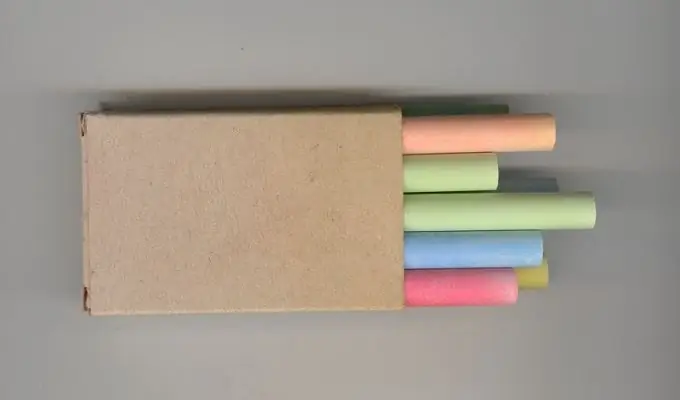- Author Nora Macey [email protected].
- Public 2023-12-16 10:17.
- Last modified 2025-01-23 08:47.
Chalk is the softest limestone rock. Surprisingly, the chalk used by schoolchildren to write on the blackboard has remained virtually unchanged since the time of cave paintings. Of course, the production process of modern chalk has been complicated in order to achieve better quality, but its functions remain the same.

What is chalk made of
The main component of chalk is calcium carbonate (CaCO3), a form of limestone. Limestone deposits are formed from coccoliths, a shell of tiny flagellar plates created from decomposed plankton skeletons. For the manufacture of pastel crayons, calcium sulfate (CaSO4) is taken as a basis, which is extracted from gypsum, an evaporite mineral that is formed from the salts of ocean water.
Chalk and dehydrated gypsum have similar properties. Pastel crayons also contain clay and oils that bind components and impart color stability. Thanks to this composition, the crayons have a velvety structure, glide smoothly over the surface and do not crumble. Although in production special attention is paid to the purification of impurities, a certain amount of them remains. The main ones are silicon, aluminum, iron, phosphorus and sulfur. Manganese, copper, titanium, sodium oxide, potassium oxide, fluorine, arsenic and strontium are present in smaller amounts.
Chalk production process
A limestone quarry is being developed for the production of chalk; usually open source development. The limestone is then crushed and ground together with water in a ball crusher (a rotating steel drum, inside of which water is sprayed). At this stage, impurities are washed out of the limestone, and a pure powder remains.
The mining of gypsum is exactly the same as that of limestone. The difference is that gypsum needs to be dehydrated in order to obtain calcium sulfate. This takes place in a special chamber, where the gypsum is heated to a temperature of 116-121 degrees Celsius. Boiling evaporates from 12 to 15 percent of its mass. Further, the gypsum is heated to 204 degrees and is removed from the chamber in this form. Then the mass is placed in a vibrating screen, where large particles are sifted out. The powder is then washed again, dried, bagged and sent to the chalk maker.
In a crayon factory, chalk or calcium sulphate is ground again. For the production of school crayons, water is added to the mass and brought to the consistency of clay. Then the mass is stamped and cut into bars about 60 cm long, which are placed in a special mold, five pieces each. This form is sent to the oven, where the mass is kept for four days at a temperature of 85 degrees Celsius. Then the hardened crayons are cut into 80 mm long bars. To make crayons, the pigments are dry mixed with the base, and only then water is added and the production cycle described above begins.






